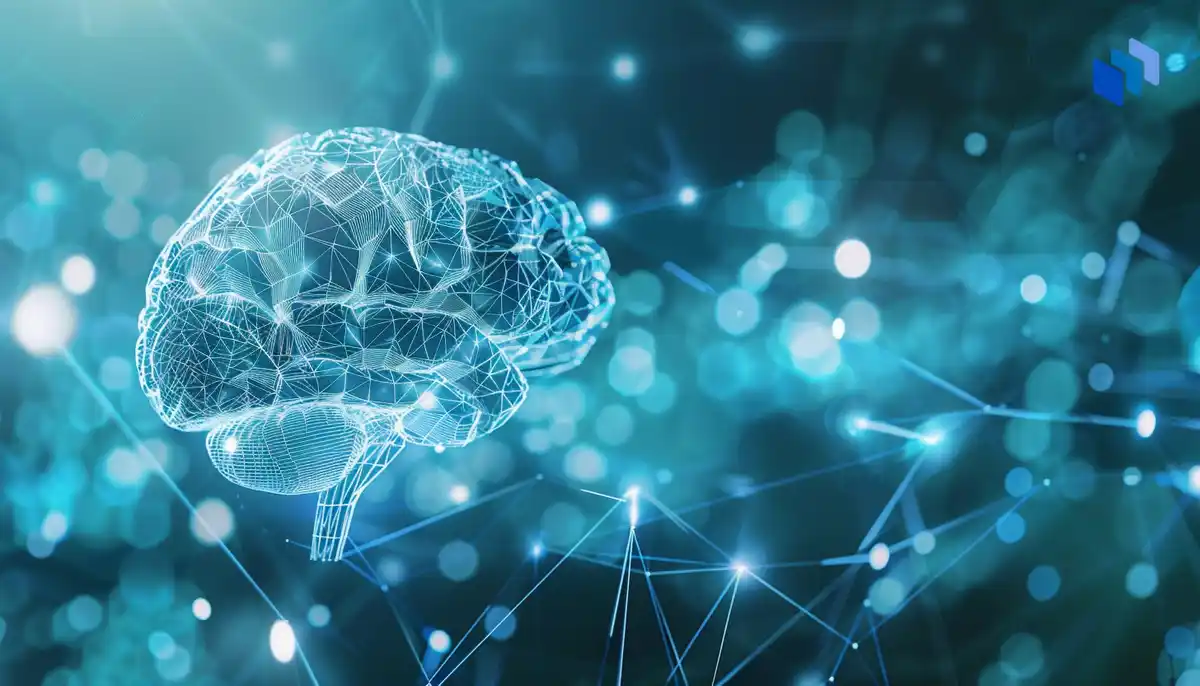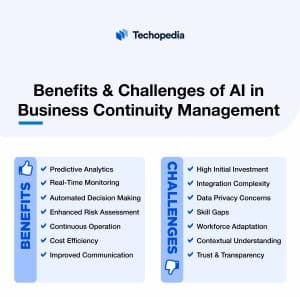Business continuity management (BCM) is a strategic approach that enables organizations to identify potential threats and implement processes to ensure that their critical operations continue during and after any disruptions.
“Business continuity management asks the question: Are you ready for when the wheels fall off? [In other words] can your business withstand and quickly recover from disruptions?” says Chantal Bisson-Krol, vice president of artificial intelligence and machine learning solutions at Kinaxis Inc., a provider of supply chain management software.
BCM involves identifying potential risks, developing strategies to mitigate those risks, and implementing plans to maintain critical functions during crises, she says. In today’s challenging business environment, companies must implement strong business continuity management practices that effectively use artificial intelligence.
In this article, we explore how AI in business continuity management can help businesses spot and mitigate potential risks. We also get expert insights on how to implement artificial intelligence efficiently.
Key Takeaways
- Incorporating AI in business continuity management is crucial for modern businesses aiming to boost resilience and efficiency.
- AI boosts the predictive and reactive capabilities of business continuity management.
- Using AI in crisis management enhances decision-making by offering real-time insights and automated solutions, which speed up response times.
- AI’s ability to predict natural disasters, supply chain problems, or cyber threats means businesses can take action early to prevent them.
Why Businesses Need AI in Business Continuity Management
In fact, incorporating AI into business continuity management is crucial for modern businesses aiming to boost resilience and efficiency. AI can process large amounts of data quickly, spotting potential risks and disruptions early, which allows companies to tackle problems before they escalate.
“Effective BCM minimizes downtime, aspires for supply chain resiliency, and safeguards against unexpected events with a view to maintaining customer trust and loyalty,” Bisson-Krol says.
AI’s ability to predict issues such as natural disasters, supply chain problems, and cyber threats means businesses can take action early to prevent them. This helps minimize downtime and keep operations running smoothly during unexpected events.
Using AI in crisis management enhances decision-making by offering real-time insights and automated solutions, which speed up response times. This quick decision-making is vital for maintaining business continuity, as it helps lessen the impact of disruptions.
Additionally, AI tools aid in improving communication and coordination across departments, ensuring that responses are unified and effective. Overall, AI boosts the predictive as well as reactive capabilities of business continuity management, helping businesses stay efficient and resilient in the face of challenges.
Benefits & Challenges of AI in Business Continuity Management
Benefits of AI in BCM
The integration of AI into business continuity management offers numerous benefits that can significantly enhance an organization’s efficiency and readiness for the future, says Sebastian Lach, partner at law firm Hogan Lovells and co-CEO of Eltemate, a Hogan Lovells technology company.
“The use of AI will also free up human resources to tackle the more complex issues that also pose the most severe threats to business continuity,” he says. “The combination of human intelligence and AI can lead to more efficient decision making, as AI processes and analyzes information much faster than humans can, delivering quick, data-driven insights.”
In addition, the cost efficiencies that come with potentially reduced downtime and optimized resource allocation also make AI a financially smart addition to business continuity management, according to Lach.
And since AI is available 24/7, it can provide continuous monitoring, and it can scale with minimal or no human intervention as the volume of data fluctuates, says Jeff Orr, director of research, digital technology with technology research and advisory firm ISG’s Ventana Research.
“AI can also assess risk by identifying potential risks and vulnerabilities and incorporating new data sources into the risk portfolio,” Orr says.
From a practical standpoint, AI tools can be used to communicate business continuity management plans, according to Octavio “OJ” Laos, director of AI lab at Armanino LLP, an accounting, consulting, and technology firm.
In a time of crisis, communication is key, and organizations could have a chatbot that has robust knowledge of the company and what to do, available at any hour of the day. Laos says:
“When you can’t get everyone on your team together or need key information to live on – you can leverage an AI front end to essentially communicate with your business, allowing for quick decision-making. Ultimately AI can help you evolve your plan as well as provide updates and new suggestions on ways you can improve.”
Challenges of Implementing AI in BCM
There’s a paradox at the heart of implementing AI in BCM today, says Paul McDonagh-Smith, senior lecturer in information technology at the MIT Sloan School of Management.
“Yes, it´s true that AI requires upfront (and ongoing) financial investment. It´s also the case that AI poses challenges in terms of integration with existing systems, and it raises critical questions regarding data privacy and security concerns.”
Ultimately, however, McDonagh-Smith says the successful deployment of AI into an organization’s BCM strategy depends on filling critical skill gaps (e.g., in data science and AI systems management) and workforce adaptation.
“If you build your BCM strategies on AI and technology alone, without factoring in the human elements of workforce development, you risk building those strategies on pillars of sand (quite literally),” he adds.
Bisson-Krol agrees.
Implementing AI in BCM comes with its own set of challenges, she says. AI should enhance, not replace, human expertise, as such factors cas ontext and collaboration are essential.
“AI is not a silver bullet. AI needs to be applied to the right problems at the right times,” Bisson-Krol says. “Its true power shines when it’s integrated into workflows for real-time decisions. Making AI accessible and understandable to everyone fosters trust and widespread use.”
Best Practices for Implementing AI in BCM
Review & Customize AI Output
Generative AI can be used to provide recommendations, draft summary emails, highlight major risks, and more, says Cate O’Malley, senior product manager at Fusion Risk Management, a provider of cloud-based operational resilience software.
However, a best practice suggests that the output should always be reviewed and tweaked as needed to fit the organization’s unique narrative and needs.
Align AI With Organizational Needs
“Another recommendation that I’ve often heard is to avoid latching onto the emerging technology simply because it exists, and instead think about the participants in your program, the problems that they have, and if emerging technology can be used to aid or mitigate those problems,” O’Malley says.
Evaluate Current BCM Processes
Lach concurs, saying companies should evaluate their current BCM processes to identify gaps and opportunities where AI could add value.
“After that, draft a plan to close those gaps and involve key stakeholders from various departments, e.g., IT, operations, privacy, compliance, to close them,” he says.
Laos, too, says that instead of thinking about outsourcing your work or tasks to the AI tool, ask what you’re missing. What else would improve your plan or assessment?
Ensure System Security
“Obviously you’ll want to make sure whatever system you use is secure before divulging specific company details, but broad strategic thinking is one of the best features of the current generations of AI,” he says.
“The next logical step is creating a repository of your own information connected to these tools so that instead of just getting a great BCM strategy, you’re getting a great strategy for your firm.”
Mitigate Risks From Open Source AI
Jenna Wells, chief customer and product officer at Supply Wisdom, a provider of third-party risk intelligence, says it’s also important to take security into consideration.
“You should be sure that AI follows your internal security procedures and doesn’t introduce more risk into your organization because many AI tools are using pieces of open source modules that are not regulated, etc.,” she says.
The Bottom Line
Integrating AI into business continuity management greatly enhances an organization’s resilience and ability to handle disruptions. AI’s capabilities in predictive analytics, automated decision-making, and real-time monitoring streamline the identification and mitigation of risks, enabling companies to approach potential threats proactively.
By implementing AI in their business continuity management strategies, companies can maintain operational efficiency, minimize downtime, and keep critical functions up and running during crises.
Ultimately, adopting AI-driven strategies not only strengthens organizations’ business continuity management plans but also fosters a culture of adaptability and innovation.







